2009 trip report
2009 - our sixth year of Fly-UK - and 46 aircraft took part.
Friday So, it's Friday 19th and the start of Fly-UK 2009. Well, it was for some. I heard that most aircraft made it to Sywell. I didn't! - I only got my rebalanced prop back on that evening. I had planned to change the spark plugs too but there just wasn't time. I packed them in my case instead! So with the wings fitted G-MWEZ was parked beside the runway at Plaistows ready for a quick get away in the morning and I got a proper bed for the night.
Saturday Up with the lark today and onto my moped for the 16 miles to the airfield. Everything ready and I was away just after 8am. To catch up I bypassed Sywell (last night's stop) and went straight to Netherthorpe (Worksop) - a two and a half hour trip. By then I was ready for a full English breakfast with extra fried bread! There were a dozen or so Fly-UK planes here as I arrived and everyone enjoyed meeting again. Others had already shot through.
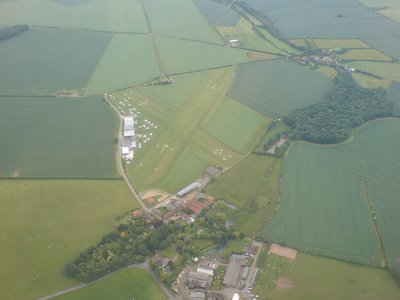
Overhead Netherthorpe
By noon we were off again, following the A1 to Fishburn, just North of Newcastle. At least 27 aircraft arrived here and there were reports of others following on. The weather was worsening with heavy showers and strong winds, so it was in a lull that we all made our move. Unfortunately my engine wouldn't start - but a quick change of the plugs did the trick. Lucky I had them!
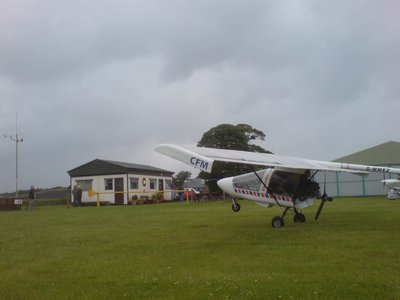
Waiting out the weather at Fishburn
The route took us north-westwards across the borders to Strathaven near Glasgow. Having to detour round a heavy shower I noticed Hadrian's Wall below and one of the forts. With 25 knot winds against us progress was slow and I would be right on the fuel limit - or beyond. So I was pleased to hear that there was only a 10 knot headwind at 5500 feet. There was just enough room between the tops of the clouds and the Glasgow airspace above for a small microlight to slip through! Then with a gradual descent I reached Strathaven after economical flying and using just over half my fuel. What a relief!

Housesteads Fort at Hadrian's Wall

Crossing the Southern Uplands
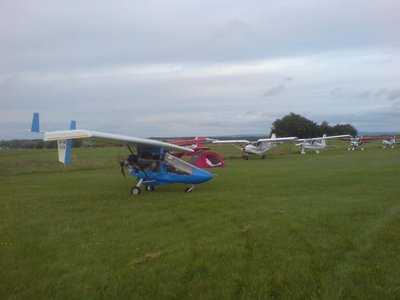
Parking up at Strathaven
There was live music in the hangar, a barbecue and a huge bonfire - Oh! And the midges, naturally. You may have heard of the 'Oh So Soft Body Oil' by Avon. No? Well it allegedly keeps the Scottish midges at bay. Today I can confirm that it works - and such soft skin too!
Sunday morning and Strathaven provided us with a fried breakfast, then with an eye to worsening weather forecast for Monday we made our plans for the day. The question was where to be weathered in for the tomorrow. Mark Harris's group chose Orkney. While others flew to Oban, Kintyre and other fields. I stayed with the majority and decided on a field on the Black Isle called Culbokie, our planned overnight stop. But, our first stop was Perth for a cup of coffee. From there we visited Inverness, a major regional airport where we parked on the north apron, safely away from the commercial jet liners. We didn't stay long and were soon making a short hop over the Solway Firth to Culbokie for a late lunch.
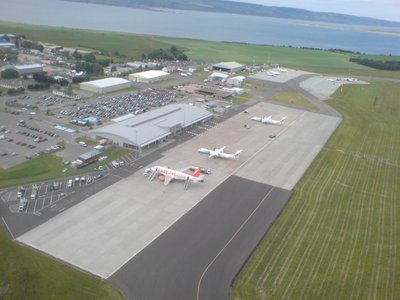
Departing Inverness Airport
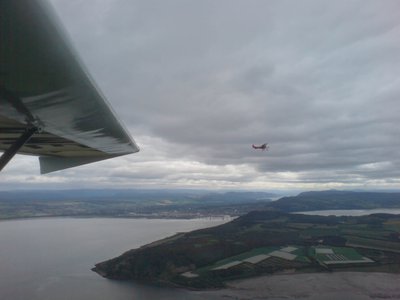
Crossing the Moray Firth
About 16 aircraft were here for the night and Antonia had organised a barbecue as well as arranging a shower cabin. We were very well looked after. This airfield is recommended as one to visit if you are on the east of Scotland. I decided on one last flight to John O'Groats and Wick, so with Paul and Neil in the Sky Ranger we took off and crossed the Cromarty Firth, only to be defeated by a bank of rain cloud. So we turned back and enjoyed our evening at Culbokie instead.
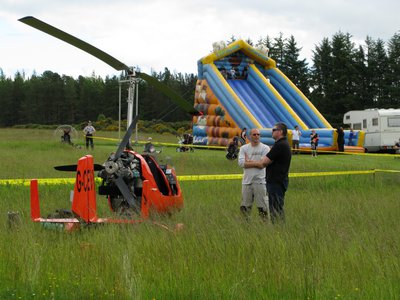
Fly-UK arrrives at Culbokie Airfield Open Day
This would make a good stop for any Scottish tour. &ensp - &ensp http://abalonebandb.com/microlighting_information.html
Check out the Fly-UK pictures on their web pages!
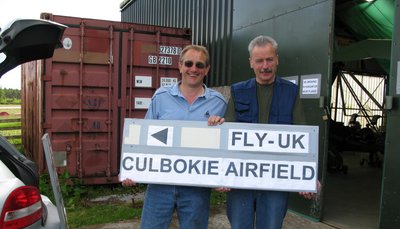
The Culbokie pilots
Later we learnt of that one of our aircraft that had made a beach landing close to Cape Wrath - perhaps the most remote location in the British Isles and a really beautiful beach. Unfortunately the sand was soft and the aircraft tipped onto its nose, breaking the prop. Fortunately some walkers were from Inverness and gave him a lift back to Culbokie. There was much discussion this evening on what to do.
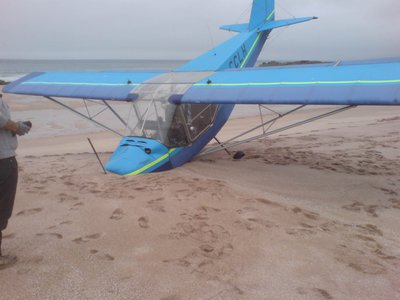
The abandoned Rans on Sandwood Bay
Monday and the weather today was against flying so it was a great opportunity to muster a gang to recover the beached aircraft. 15 of us set off on a 2 hour drive across from Culbokie to Cape Wrath.
The access to the beach is on foot only and starts with a two and a half mile track suitable for a 4 wheel drive vehicle. It then deteriorates into a footpath which is strewn with rocks and just wide enough for single file over much of its length. On either side is rough moorland. Getting the aircraft out would be difficult. A fast walk brought us to the beach in one hour and ten minutes. The aircraft was sitting just below high water with its nose wheel collapsed and its tail in the air. Unfortunately the tide had washed over the engine, filling the engine bay with sand.
The task of dismantling began with the removal of the wings and the draining of the fuel into jerry cans. Meanwhile the sand was removed from the engine bay and the aircraft nose lifted so that the engine could be removed. With wings off and engine removed it would be easier to drag the fuselage back along the track. So one hour and twenty minutes later we set off back. A couple of walkers came across us working on the aircraft and were delighted to find such a strange event going on in such a remote location! They took pictures, and then proceeded to help us carry the aircraft out. Many thanks are owed to them. We sent a scout ahead to find the best way through the dunes and with 4 people to the engine, 2 to each wing and 8 to the fuselage, the return trip began. We had to leave the fuel and about a gallon of oil behind. Another aircraft would fly in at the weekend to collect it.
It was not easy bringing the aircraft out - firstly through soft sand, then across the dunes and up a steep slope to the footpath. On the path it was probably easiest carrying the wings; with a person at each end and the wing held on their heads the carriers could walk in single file down the track. Carrying the engine was not so simple as the track was not wide and one person would be on the path while another was up the bank. It was similar for the fuselage; one wheel on the track and the other off it. We all struggled with the uneven ground and the large stones on the track, some of which were as tall as the wheels. Meanwhile a light drizzle started, which left us all soaked. At the start of the vehicle track we left the engine in a borrowed trailer and pressed on to the road. It was easier on the wider track and four and a half hours after leaving the beach we had the aircraft in a barn for collection later in the week. Job done we set off back to Culbokie, drying out on the way.
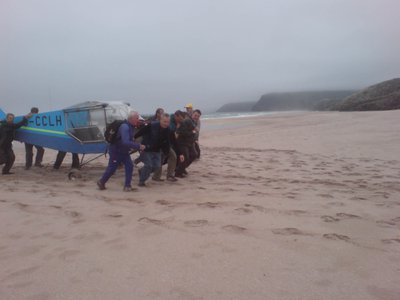
Retrieving a Rans from Sandwood Bay
Tuesday and the weather was improving. Leaving Culbokie at 8.30 we set off down the Great Glen in sunshine with views across to distant mountains. It was a very pleasant flight with a view of Ben Nevis complete with snow on its northern face. Rounding the corner towards Oban and North Connel airfield the weather changed. Low cloud forced us down below 400 feet as we flew between the islands in Loch Linnhe. Fortunately the cloud base lifted and we had sunshine as we landed for our refuelling stop. Oban were very welcoming, as usual, but no cafe! Our plan, to catch up on the lost day, was to head south, missing most of the islands in the Hebrides (though other Fly-UK members reached most islands).
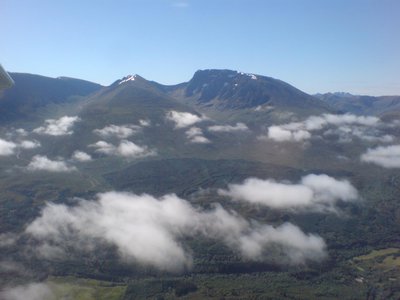
Ben Nevis from Loch Ness

Diving below clouds on the approach to Oban
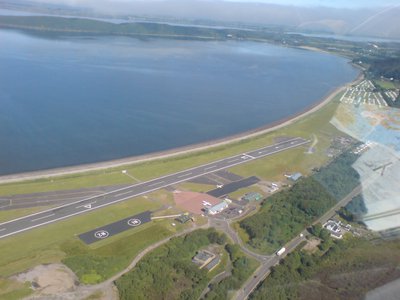
Oban in the sunshine
We followed the coast with fantastic views across the islands of Mull, Jura and Islay, crossed the Mull of Kintyre at the Crinnan Canal and landed next on Bute; a very simple grass strip which is known to have a local pub with excellent food. The Ploughman's Lunch was superb and almost too much - see photo! So two hours later we were on our way again.
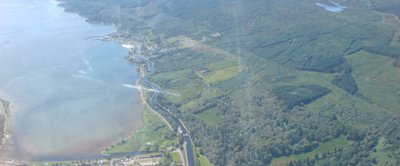
Lochgilphead and the Crinan Canal
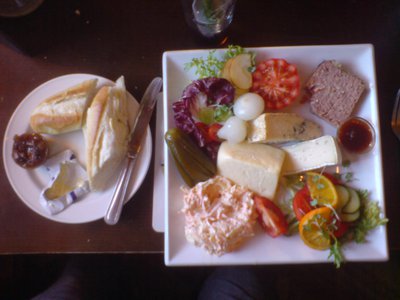
Lunch on Bute
We crossed the Sound of Bute to Ardrossan, over the restricted area around the power station at 2000+ feet, to fly through the narrow corridor that separates Prestwick airspace from the Glasgow zone. This corridor is only a few kilometres wide and careful navigation is essential if an infringement of controlled airspace is to be avoided. After Kilmarnock the route opens up and a direct course was set for Carlisle, using the M74 as a pointer and arriving at 5pm. Refuelling was completed, tents erected and we were given a lift to the pub by the Chief Flying Instructor of the microlight school, Dave. Sleep was only disturbed by the morning calls of the Skylark.
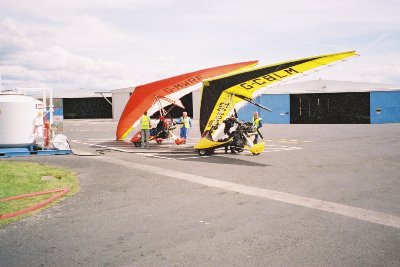
Refuelling at Carlisle Airport
Leaving Carlisle on the Wednesday morning we set course for the Lakes. From Penrith I headed up Ullswater and over the top into the Windermere valley, just a few hundred feet above the ground at the top then following the lake to Morecombe bay. It was less turbulent across the water compared with the air in the hills! The coast and the M6 showed the way until approaching Blackpool and the military base at Warton. At 5 miles away I called by radio, requesting permission to penetrate their zone, which brought approval if at 2000 feet. This was welcome as it would save a long detour. Then just as I was about to enter the zone I was turned away and told to fly east remaining outside the zone. This was disappointing, but then a moment later permission was reinstated at not below 2500 feet. And with that I crossed over the centre of the runway with a fast jet doing circuits and bumps, flying just 1000 feet below. Once clear of Warton I was heading for the Wirral, flying just off the Liverpool seafront in a low level corridor not above 1500 feet across the water.
Arriving in Wales I decided to miss the planned stop at Caernarfon as the wind was from the east and would cause turbulent air. Instead I made a detour to Denbigh to take some photos as I have a connection in the area. From there I took a straight line past Bala Lake and between the hills to the coast near Aberystwyth. The picture shows a Welsh mountain with the reflection of my chart in the canopy. There is a danger area at Aber that all aircraft must avoid due to the use of powerful lasers.
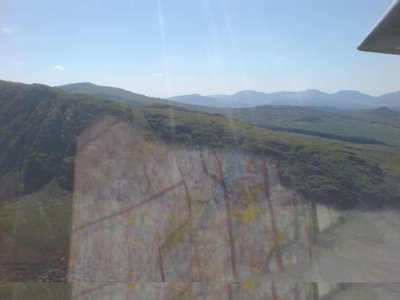
Looking towards Snowdonia
My next visit was to a National Trust property along the route that I had previously visited, where I took a couple of photos. Then, avoiding the West Wales airport at Aberporth I turned towards a field I have in Pembrokeshire A couple of low passes convinced me that I could land there - but not before the farmer took the hay! And so into Haverfordwest airport where the landing fees had generously been waived. I arrived just as the airfield was being closed for the night, but the manager made a point of welcoming me and asked whether Fly-UK would like an overnight stop there next year. Possibly! A quick refuel and I was on my way to Swansea for the night.
Almost the last to arrive, I parked, pitched the tent and begged a lift to the nearest village and a meal at the pub. By then I had caught up with a number of the other pilots and at the end of the evening we shared a taxi back to the field. I had pitched my tent close to a concrete base which had probably supported a searchlight on this WW2 airfield. The grass there cannot have been cut in years - I had a particularly lumpy and wakefull night.

Arrived at Swansea
Thursday morning we waited for the fuel bowser to open for refuelling then departed eastwards for a point to cross the Bristol Channel. The choice is between a longer crossing before Cardiff's airspace or a shorter crossing after. The group was split with some taking each route. I elected for the longer crossing, so in the company of Andy in a flexwing we flew round Swansea bay, climbing to 4000 feet for safety over the water and set a course between Nash Point and Minehead keeping in touch with Cardiff radar on the crossing. About half way across we met low cloud and had to drop down to 1200 to get below it. We also had to route further eastward because the cloud was sitting on the Quantox and we couldn't turn inland until past Dunster. At that point we were able to track the valley towards Taunton and turn past Wellington into Dunkeswell airfield. At this point the cloud was becoming more broken and the field was active with parachuting which made interesting viewing during our late breakfast.
By this time there was a forecast of stronger easterly winds developing and a trip to the Isles of Scilly seemed unlikely. Getting back could be difficult. So from Dunkeswell we flew over Crediton, Oakhampton, Launceton, Bodmin and into Perranporth. Here the wind was blowing 16 knots gusting 25, which made landing on the cliff top interesting. We tied down securely before refuelling and visiting the cafe. The forecast suggested that tomorrow might not be a good flying day so rather than stay at Truro we chose to return eastwards to Bodmin. Here they lent us the keys to the clubhouse and bar and we took a taxi for a meal. The driver dropped us at Bodmin Jail, now a pleasant restaurant! Back at the airfield we made full use of the club house and bar then returned to our tents on top of the hill.
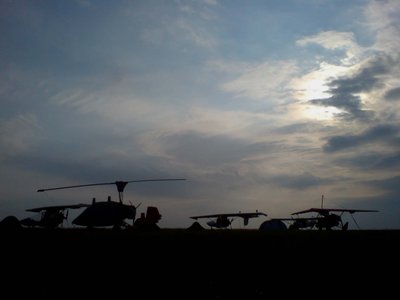
Fly-UK - Overnight at Bodmin
Friday and Bodmin cooked us a delicious breakfast, then we waited for the weather to improve to the east before heading for the clearer weather on the coast. There was a band of stormy weather running north-westwards through Glastonbury - the festival was on of course! By about noon it was clearing to the east so we landed at Bolt Head near Salcombe for a review.
The airfield at Bolt head is very remote with no facilities whatsoever, so we felt that a Ł10 landing charge was excessive. I shan't be back.
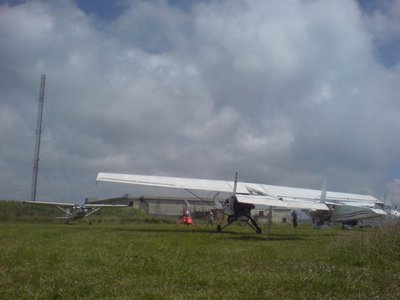
Bolt Head - Not worth the £10 landing fee!
We departed over the estuary at Salcombe (taking pictures) and on to Farway Common, run by Terry who welcomed us with a cup of tea. We had an enjoyable hour or two in his company. By this time the storms were moving away from the south and we managed to get past the southern end of them and into Compton Abbas airfield near Shaftesbury. The owners even lent us their car for a trip into town for dinner at the Indian restaurant. Handsome!
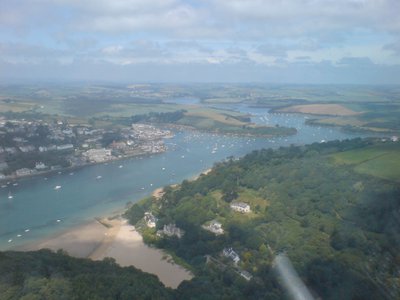
The Salcombe estuary
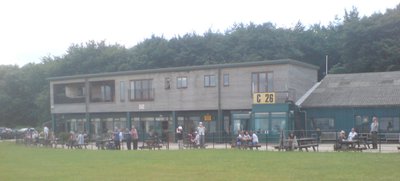
Compton Abbas
Saturday We awoke this morning with a mist around the tents. Compton Abbas airfield is 800 feet above sea level - cloud base was lower. So it was noon before we were airborne and heading for Clench Common. Passing around the outside of the Boscombe Down danger area past Warminster I took a picture of the white horse at Westbury before following the railway towards Clench. By this time we were in glorious sunshine and it seemed that the bad weather was at last behind us. Graham Slater, CFI at Clench made us very welcome and we had a pleasant hour there.
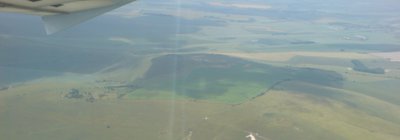
The White Horse at Westbury with a crop circle in the foreground (image truncated)
Ian, a fellow participant of Fly-UK who had spent the night on the Dorset coast, had arrived back home at Bakersfield near Corby, and invited us in for a fuel top up and a brew. That's always hard to turn down, so that was our next destination. Unfortunately the weather deteriorated as it became very hazy near Sywell. A GA aircraft heading in the reciprocal direction suddenly appeared out of the haze and reminded us of the limited visibility. I dropped down into slightly clearer air and followed Colin in the other Shadow microlight - he seemed to know where he was going. By this time the flexwing pilot in our group, Andy who knew the area, had gone on ahead to land before us at Bakersfield. He called back that there was some rain ahead but the cloud base and visibility was adequate.
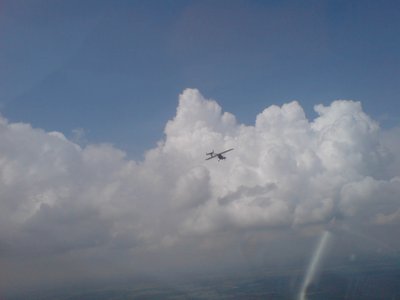
Heading into worsening weather
Our GPSs were very useful in confirming our position and pointing us towards the airfield. But by the time we reached the indicated location the field could not be found. Fortunately Andy was able to give us precise directions from the ground, preventing this from becoming too 'scarey'. We were all glad to be safely on the ground.
After a cuppa we sat out the worst of the weather and then with brightening skies we continued to Sutton Meadows. A round of the National microlight competitions was being held here and we sat in the sun watching the spot landings competition. A barbecue was set up and we all ate well.
Now, while I write this I can here the band singing Jake Thackray songs, so please excuse me for ending this here. Another great trip round Britain. Thanks to everyone who joined in - the pilots, passengers, air traffic controllers and the many airfield cafe staff. Without your support it would not be Fly-UK.
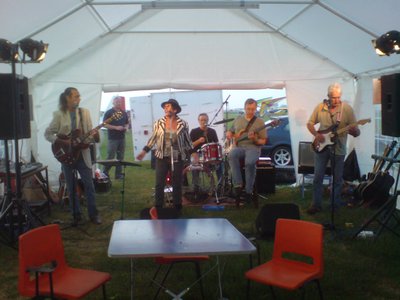
The Band at Sutton Meadows
2009 - our sixth year of Fly-UK - and 46 aircraft took part.
Friday So, it's Friday 19th and the start of Fly-UK 2009. Well, it was for some. I heard that most aircraft made it to Sywell. I didn't! - I only got my rebalanced prop back on that evening. I had planned to change the spark plugs too but there just wasn't time. I packed them in my case instead! So with the wings fitted G-MWEZ was parked beside the runway at Plaistows ready for a quick get away in the morning and I got a proper bed for the night.
Saturday Up with the lark today and onto my moped for the 16 miles to the airfield. Everything ready and I was away just after 8am. To catch up I bypassed Sywell (last night's stop) and went straight to Netherthorpe (Worksop) - a two and a half hour trip. By then I was ready for a full English breakfast with extra fried bread! There were a dozen or so Fly-UK planes here as I arrived and everyone enjoyed meeting again. Others had already shot through.

Overhead Netherthorpe
By noon we were off again, following the A1 to Fishburn, just North of Newcastle. At least 27 aircraft arrived here and there were reports of others following on. The weather was worsening with heavy showers and strong winds, so it was in a lull that we all made our move. Unfortunately my engine wouldn't start - but a quick change of the plugs did the trick. Lucky I had them!

Waiting out the weather at Fishburn
The route took us north-westwards across the borders to Strathaven near Glasgow. Having to detour round a heavy shower I noticed Hadrian's Wall below and one of the forts. With 25 knot winds against us progress was slow and I would be right on the fuel limit - or beyond. So I was pleased to hear that there was only a 10 knot headwind at 5500 feet. There was just enough room between the tops of the clouds and the Glasgow airspace above for a small microlight to slip through! Then with a gradual descent I reached Strathaven after economical flying and using just over half my fuel. What a relief!

Housesteads Fort at Hadrian's Wall

Crossing the Southern Uplands

Parking up at Strathaven
There was live music in the hangar, a barbecue and a huge bonfire - Oh! And the midges, naturally. You may have heard of the 'Oh So Soft Body Oil' by Avon. No? Well it allegedly keeps the Scottish midges at bay. Today I can confirm that it works - and such soft skin too!
Sunday morning and Strathaven provided us with a fried breakfast, then with an eye to worsening weather forecast for Monday we made our plans for the day. The question was where to be weathered in for the tomorrow. Mark Harris's group chose Orkney. While others flew to Oban, Kintyre and other fields. I stayed with the majority and decided on a field on the Black Isle called Culbokie, our planned overnight stop. But, our first stop was Perth for a cup of coffee. From there we visited Inverness, a major regional airport where we parked on the north apron, safely away from the commercial jet liners. We didn't stay long and were soon making a short hop over the Solway Firth to Culbokie for a late lunch.

Departing Inverness Airport

Crossing the Moray Firth
About 16 aircraft were here for the night and Antonia had organised a barbecue as well as arranging a shower cabin. We were very well looked after. This airfield is recommended as one to visit if you are on the east of Scotland. I decided on one last flight to John O'Groats and Wick, so with Paul and Neil in the Sky Ranger we took off and crossed the Cromarty Firth, only to be defeated by a bank of rain cloud. So we turned back and enjoyed our evening at Culbokie instead.

Fly-UK arrrives at Culbokie Airfield Open Day
This would make a good stop for any Scottish tour. &ensp - &ensp http://abalonebandb.com/microlighting_information.html
Check out the Fly-UK pictures on their web pages!

The Culbokie pilots
Later we learnt of that one of our aircraft that had made a beach landing close to Cape Wrath - perhaps the most remote location in the British Isles and a really beautiful beach. Unfortunately the sand was soft and the aircraft tipped onto its nose, breaking the prop. Fortunately some walkers were from Inverness and gave him a lift back to Culbokie. There was much discussion this evening on what to do.

The abandoned Rans on Sandwood Bay
Monday and the weather today was against flying so it was a great opportunity to muster a gang to recover the beached aircraft. 15 of us set off on a 2 hour drive across from Culbokie to Cape Wrath.
The access to the beach is on foot only and starts with a two and a half mile track suitable for a 4 wheel drive vehicle. It then deteriorates into a footpath which is strewn with rocks and just wide enough for single file over much of its length. On either side is rough moorland. Getting the aircraft out would be difficult. A fast walk brought us to the beach in one hour and ten minutes. The aircraft was sitting just below high water with its nose wheel collapsed and its tail in the air. Unfortunately the tide had washed over the engine, filling the engine bay with sand.
The task of dismantling began with the removal of the wings and the draining of the fuel into jerry cans. Meanwhile the sand was removed from the engine bay and the aircraft nose lifted so that the engine could be removed. With wings off and engine removed it would be easier to drag the fuselage back along the track. So one hour and twenty minutes later we set off back. A couple of walkers came across us working on the aircraft and were delighted to find such a strange event going on in such a remote location! They took pictures, and then proceeded to help us carry the aircraft out. Many thanks are owed to them. We sent a scout ahead to find the best way through the dunes and with 4 people to the engine, 2 to each wing and 8 to the fuselage, the return trip began. We had to leave the fuel and about a gallon of oil behind. Another aircraft would fly in at the weekend to collect it.
It was not easy bringing the aircraft out - firstly through soft sand, then across the dunes and up a steep slope to the footpath. On the path it was probably easiest carrying the wings; with a person at each end and the wing held on their heads the carriers could walk in single file down the track. Carrying the engine was not so simple as the track was not wide and one person would be on the path while another was up the bank. It was similar for the fuselage; one wheel on the track and the other off it. We all struggled with the uneven ground and the large stones on the track, some of which were as tall as the wheels. Meanwhile a light drizzle started, which left us all soaked. At the start of the vehicle track we left the engine in a borrowed trailer and pressed on to the road. It was easier on the wider track and four and a half hours after leaving the beach we had the aircraft in a barn for collection later in the week. Job done we set off back to Culbokie, drying out on the way.

Retrieving a Rans from Sandwood Bay
Tuesday and the weather was improving. Leaving Culbokie at 8.30 we set off down the Great Glen in sunshine with views across to distant mountains. It was a very pleasant flight with a view of Ben Nevis complete with snow on its northern face. Rounding the corner towards Oban and North Connel airfield the weather changed. Low cloud forced us down below 400 feet as we flew between the islands in Loch Linnhe. Fortunately the cloud base lifted and we had sunshine as we landed for our refuelling stop. Oban were very welcoming, as usual, but no cafe! Our plan, to catch up on the lost day, was to head south, missing most of the islands in the Hebrides (though other Fly-UK members reached most islands).

Ben Nevis from Loch Ness

Diving below clouds on the approach to Oban

Oban in the sunshine
We followed the coast with fantastic views across the islands of Mull, Jura and Islay, crossed the Mull of Kintyre at the Crinnan Canal and landed next on Bute; a very simple grass strip which is known to have a local pub with excellent food. The Ploughman's Lunch was superb and almost too much - see photo! So two hours later we were on our way again.

Lochgilphead and the Crinan Canal

Lunch on Bute
We crossed the Sound of Bute to Ardrossan, over the restricted area around the power station at 2000+ feet, to fly through the narrow corridor that separates Prestwick airspace from the Glasgow zone. This corridor is only a few kilometres wide and careful navigation is essential if an infringement of controlled airspace is to be avoided. After Kilmarnock the route opens up and a direct course was set for Carlisle, using the M74 as a pointer and arriving at 5pm. Refuelling was completed, tents erected and we were given a lift to the pub by the Chief Flying Instructor of the microlight school, Dave. Sleep was only disturbed by the morning calls of the Skylark.

Refuelling at Carlisle Airport
Leaving Carlisle on the Wednesday morning we set course for the Lakes. From Penrith I headed up Ullswater and over the top into the Windermere valley, just a few hundred feet above the ground at the top then following the lake to Morecombe bay. It was less turbulent across the water compared with the air in the hills! The coast and the M6 showed the way until approaching Blackpool and the military base at Warton. At 5 miles away I called by radio, requesting permission to penetrate their zone, which brought approval if at 2000 feet. This was welcome as it would save a long detour. Then just as I was about to enter the zone I was turned away and told to fly east remaining outside the zone. This was disappointing, but then a moment later permission was reinstated at not below 2500 feet. And with that I crossed over the centre of the runway with a fast jet doing circuits and bumps, flying just 1000 feet below. Once clear of Warton I was heading for the Wirral, flying just off the Liverpool seafront in a low level corridor not above 1500 feet across the water.
Arriving in Wales I decided to miss the planned stop at Caernarfon as the wind was from the east and would cause turbulent air. Instead I made a detour to Denbigh to take some photos as I have a connection in the area. From there I took a straight line past Bala Lake and between the hills to the coast near Aberystwyth. The picture shows a Welsh mountain with the reflection of my chart in the canopy. There is a danger area at Aber that all aircraft must avoid due to the use of powerful lasers.

Looking towards Snowdonia
My next visit was to a National Trust property along the route that I had previously visited, where I took a couple of photos. Then, avoiding the West Wales airport at Aberporth I turned towards a field I have in Pembrokeshire A couple of low passes convinced me that I could land there - but not before the farmer took the hay! And so into Haverfordwest airport where the landing fees had generously been waived. I arrived just as the airfield was being closed for the night, but the manager made a point of welcoming me and asked whether Fly-UK would like an overnight stop there next year. Possibly! A quick refuel and I was on my way to Swansea for the night.
Almost the last to arrive, I parked, pitched the tent and begged a lift to the nearest village and a meal at the pub. By then I had caught up with a number of the other pilots and at the end of the evening we shared a taxi back to the field. I had pitched my tent close to a concrete base which had probably supported a searchlight on this WW2 airfield. The grass there cannot have been cut in years - I had a particularly lumpy and wakefull night.

Arrived at Swansea
Thursday morning we waited for the fuel bowser to open for refuelling then departed eastwards for a point to cross the Bristol Channel. The choice is between a longer crossing before Cardiff's airspace or a shorter crossing after. The group was split with some taking each route. I elected for the longer crossing, so in the company of Andy in a flexwing we flew round Swansea bay, climbing to 4000 feet for safety over the water and set a course between Nash Point and Minehead keeping in touch with Cardiff radar on the crossing. About half way across we met low cloud and had to drop down to 1200 to get below it. We also had to route further eastward because the cloud was sitting on the Quantox and we couldn't turn inland until past Dunster. At that point we were able to track the valley towards Taunton and turn past Wellington into Dunkeswell airfield. At this point the cloud was becoming more broken and the field was active with parachuting which made interesting viewing during our late breakfast.
By this time there was a forecast of stronger easterly winds developing and a trip to the Isles of Scilly seemed unlikely. Getting back could be difficult. So from Dunkeswell we flew over Crediton, Oakhampton, Launceton, Bodmin and into Perranporth. Here the wind was blowing 16 knots gusting 25, which made landing on the cliff top interesting. We tied down securely before refuelling and visiting the cafe. The forecast suggested that tomorrow might not be a good flying day so rather than stay at Truro we chose to return eastwards to Bodmin. Here they lent us the keys to the clubhouse and bar and we took a taxi for a meal. The driver dropped us at Bodmin Jail, now a pleasant restaurant! Back at the airfield we made full use of the club house and bar then returned to our tents on top of the hill.

Fly-UK - Overnight at Bodmin
Friday and Bodmin cooked us a delicious breakfast, then we waited for the weather to improve to the east before heading for the clearer weather on the coast. There was a band of stormy weather running north-westwards through Glastonbury - the festival was on of course! By about noon it was clearing to the east so we landed at Bolt Head near Salcombe for a review.
The airfield at Bolt head is very remote with no facilities whatsoever, so we felt that a Ł10 landing charge was excessive. I shan't be back.

Bolt Head - Not worth the £10 landing fee!
We departed over the estuary at Salcombe (taking pictures) and on to Farway Common, run by Terry who welcomed us with a cup of tea. We had an enjoyable hour or two in his company. By this time the storms were moving away from the south and we managed to get past the southern end of them and into Compton Abbas airfield near Shaftesbury. The owners even lent us their car for a trip into town for dinner at the Indian restaurant. Handsome!

The Salcombe estuary

Compton Abbas
Saturday We awoke this morning with a mist around the tents. Compton Abbas airfield is 800 feet above sea level - cloud base was lower. So it was noon before we were airborne and heading for Clench Common. Passing around the outside of the Boscombe Down danger area past Warminster I took a picture of the white horse at Westbury before following the railway towards Clench. By this time we were in glorious sunshine and it seemed that the bad weather was at last behind us. Graham Slater, CFI at Clench made us very welcome and we had a pleasant hour there.

The White Horse at Westbury with a crop circle in the foreground (image truncated)
Ian, a fellow participant of Fly-UK who had spent the night on the Dorset coast, had arrived back home at Bakersfield near Corby, and invited us in for a fuel top up and a brew. That's always hard to turn down, so that was our next destination. Unfortunately the weather deteriorated as it became very hazy near Sywell. A GA aircraft heading in the reciprocal direction suddenly appeared out of the haze and reminded us of the limited visibility. I dropped down into slightly clearer air and followed Colin in the other Shadow microlight - he seemed to know where he was going. By this time the flexwing pilot in our group, Andy who knew the area, had gone on ahead to land before us at Bakersfield. He called back that there was some rain ahead but the cloud base and visibility was adequate.

Heading into worsening weather
Our GPSs were very useful in confirming our position and pointing us towards the airfield. But by the time we reached the indicated location the field could not be found. Fortunately Andy was able to give us precise directions from the ground, preventing this from becoming too 'scarey'. We were all glad to be safely on the ground.
After a cuppa we sat out the worst of the weather and then with brightening skies we continued to Sutton Meadows. A round of the National microlight competitions was being held here and we sat in the sun watching the spot landings competition. A barbecue was set up and we all ate well.
Now, while I write this I can here the band singing Jake Thackray songs, so please excuse me for ending this here. Another great trip round Britain. Thanks to everyone who joined in - the pilots, passengers, air traffic controllers and the many airfield cafe staff. Without your support it would not be Fly-UK.

The Band at Sutton Meadows